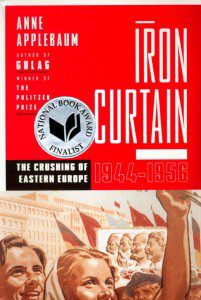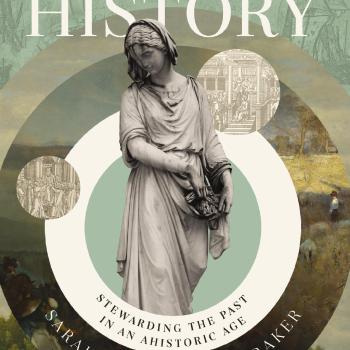Oftentimes the most powerful accounts of “religious history” are found in books addressing much broader topics. Such is the case in Anne Applebaum’s convincing and eloquent The Iron Curtain: The Crushing of Eastern Europe, 1944-1956 (Doubleday, 2012). Focusing on events in East Germany, Poland, and Hungary, Applebaum uses both archival sources and oral interviews to chronicle the rise of totalitarianism in Eastern Europe.
Max Frankel wrote a rather dismissive review of the book for the New York Times. While Frankel allows that Applebaum’s evidence “is overwhelming and convincing,” he complains that “the heart of her story is hardly news.” For those with a good working knowledge of early Cold War history, Frankel is correct. Anyone with a passing recollection of this ugly chapter of history knows that the Soviet Union imposed brutal dictatorships on what became known as the Eastern Bloc.
 Nevertheless, Applebaum’s book is important in several respects. First, it is still quite common in standard U.S. History textbooks for authors to at the very least assign equal blame for the rise of the Cold War to the United States and the Soviet Union. Stalin’s intentions, so this argument goes, were not especially provocative, at least beyond his desire to secure a buffer of sorts between American-influenced Western Europe and Soviet borders. A variation of this argument suggests that the Soviet Union only eliminated political freedoms in Eastern Europe as a response to hostile American steps.
Nevertheless, Applebaum’s book is important in several respects. First, it is still quite common in standard U.S. History textbooks for authors to at the very least assign equal blame for the rise of the Cold War to the United States and the Soviet Union. Stalin’s intentions, so this argument goes, were not especially provocative, at least beyond his desire to secure a buffer of sorts between American-influenced Western Europe and Soviet borders. A variation of this argument suggests that the Soviet Union only eliminated political freedoms in Eastern Europe as a response to hostile American steps.
Applebaum entirely rejects such arguments (usually described as “revisionist”). “Any close examination of what was happening on the ground across the region between 1944 and 1947,” she concludes, points to nefarious intentions of both Stalin and local communist leaders from the get-go. As the Soviets “liberated” Nazi-held territory, they began to create secret police forces which arrested alleged political enemies (often those non-communists who had resisted Nazi occupation), gained control of mass media, and systematically neutered “many of the independent organizations of what we would now call civil society.” This argument is important, and although she does not interrupt her narrative to argue it throughout her chapters, she provides a massive amount of support for it in the first section of the book.
In my seven years of teaching modern U.S. History, I frequently encountered students with one of two viewpoints: 1) the Cold War was simply a morally neutral struggle between two superpowers (“moral equivalence”); 2) the United States represented the forces of good against evil. Both of those are entirely inadequate.
I’ve long enjoyed this sentence in John Lewis Gaddis’s brief history of the Cold War: “Despite the legacy of slavery, the near extermination of native Americans, and persistent racial, sexual, and social discrimination, the citizens of the United States could plausibly claim, in 1945, to live in the freest society on the face of the earth.” It’s a strange sentence — an enormous claim preceded by a host of damning qualifications. Both parts are important. At the same time, argues Gaddis, “the Union of Soviet Socialist Republics was, at the end of World War II, the most authoritarian society anywhere on the face of the earth.” Perhaps one could find candidates for a more authoritarian society, but it’s hard for me to take issue with either of these conclusions.
Applebaum isn’t writing a history of the early Cold War, so such concerns are not hers. Nevertheless, as the Cold War recedes into the more distant reaches of collective consciousness, readers need fresh accounts of the horror of Stalinist totalitarianism. The details still stun, as in this description of Soviet looting: “the Red Army even confiscated the feed for the animals from the Leipzig zoo in October 1945. A few months later, the Red Army confiscated the animals as well and apparently took them to Russia.” The naiveté / duplicity of leftist intellectuals continues to amaze me as well, as in this insight from the existentialist philosopher and enthusiastic fellow traveler Jean-Paul Sartre: “‘Like you I find these camps intolerable,’ he told Arlbert Camus, speaking of the Soviet Gulag. ‘But I find equally intolerable the use made of them every day in the bourgeois press.'” Really?
For the most part, The Iron Curtain makes for depressing reading. It’s a story of mass arrests, show trials, executions, deportations, and ethnic cleansing. There are delightful sections, as when the voters of Eastern Europe repeatedly disappoint their communist leaders in the relatively free elections that followed the end of the war. And, of course, there is a full panoply of heroes, as well as the brief excitement of the 1956 revolt in Hungary. Applebaum notes that very many observers believed that once entrenched, totalitarian regimes become “nearly invincible.” The Hungarian Revolution both questioned that belief and — because it failed — reinforced it. The author, however, interprets the failed revolt optimistically: “the spell can suddenly, unexpectedly, dramatically be broken. ” True, but the Cold War endured another forty-plus years.
Applebaum’s book is one of the best general-interest works of history I’ve read in recent years. The research is deep, the prose is clear and often eloquent, and the lessons remain important: the nature of totalitarianism, the importance of civil society beyond state control, the moral dilemma facing all citizens living under oppressive regimes (no need for outsiders to make snap judgments), and the human capacity for great evil.
When I began The Iron Curtain, I was curious to see how (and how much) Applebaum would discuss Eastern European churches. I was not disappointed. I’ll discuss that material next week.











